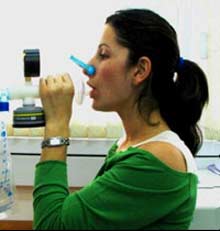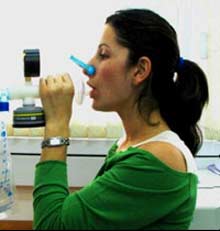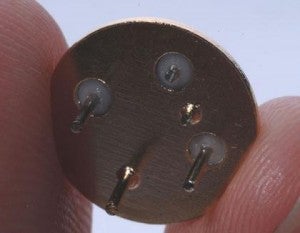Newest Breathalyser Knows if You Have Lung Cancer

Share

Not only have you had too many drinks, you've also got a tumor. Researchers at the Israeli Institute of Technology have developed a device that can analyze your breath for particles that indicate you have lung cancer. The breathalyser, which works using gold nanoparticles to detect volatile organic compounds (VOCs) is potentially the cheapest and easiest way to screen for the deadly disease. Researchers believe that they will be able to start clinical trials in just 2 to 3 years, meaning we may soon see breathalysers moving from the squad car to the doctor's office.
Lung cancer kills more than 150,000 people in the US alone each year, and is one of the most difficult forms of cancer to detect early and efficiently. Current methods include complicated biopsies which have associated risks given the sensitive nature of the organ. While the Israeli device is not the first breathalyser hoping to detect lung cancer, it does have the potential to be the cheapest. Most others require complicated optical scans or mass spectrometry. The new device is also better at working in the humid and fluctuating atmosphere of your breath. Which, let's admit, isn't always as fresh as you hope.
While scientists have discovered 42 different VOCs that may indicate you have lung cancer, the IIT device concentrates on discovering just 4 of them. Hossam Haick, who lead the team, says that the breakthrough comes after building gold nanoparticles that stick very well to these VOCs. The nature of that stickiness is under wraps and is in the process of being patented.
With those sticky nanoparticles, Haick built a chemiresistor - a small device that changes resistance with chemical changes - that can detect VOCs at a level of just a few parts per billion. That's a definite necessity as healthy levels (1-20 ppb) and cancerous levels (10-100 ppb) aren't that far apart. Haick's device may be sensitive enough, in fact, to determine what stage of lung cancer a patient has.
Be Part of the Future
Sign up to receive top stories about groundbreaking technologies and visionary thinkers from SingularityHub.



Detecting lung cancer on your breath isn't a revolutionary idea of course. There have been other breathalysers, and perhaps the most accurate detection devices to date are trained dogs. Yep, with the right know-how, a dog can point out the human in the room with lung cancer about 99% of the time. While I doubt that Haick's electronic nose can beat the canine's yet, it is certainly more portable and reproducible. Also, the sticky nanoparticles may be used to detect not just lung cancer, but other ailments such as liver disease.
Non-invasive diagnosis tools are the future of cancer detection. Breathalysers are likely to find a home along side sonograms and infrared scans. As these techniques become cheaper and more reliable, we may see them progress out of the doctor's office and into home medicine. Already we've seen how health monitors, biosensor controllers, and even smart toilets are giving medical analysis tools to consumers. With lung cancer such a prevalent killer, you can bet a breathalyser would be a popular device as well.
[photo credits: Nature Nanotechnology, Hossam Haick]
Related Articles

This Light-Powered AI Chip Is 100x Faster Than a Top Nvidia GPU

This Week’s Awesome Tech Stories From Around the Web (Through December 20)

Data Centers in Space: Will 2027 Really Be the Year AI Goes to Orbit?
What we’re reading